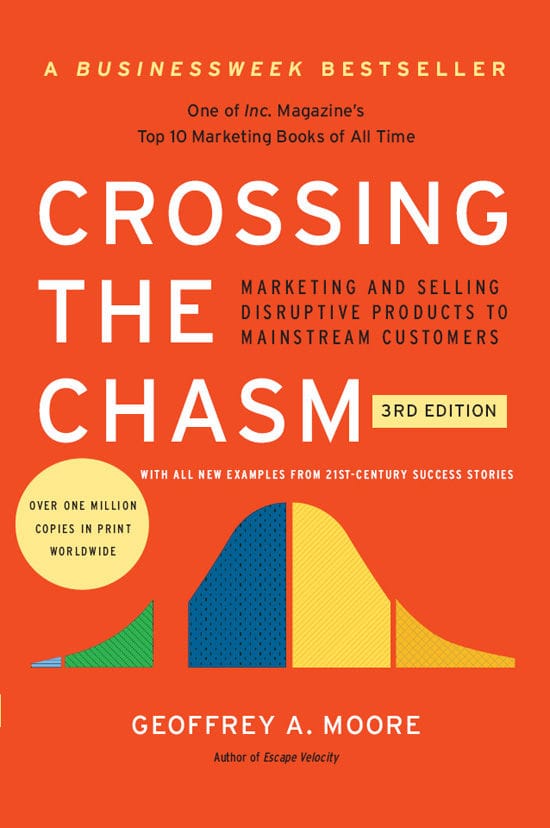Crossing the Chasm: A Briefing on High-Tech Marketing

This briefing document reviews the main themes and crucial insights from Geoffrey A. Moore's seminal work, "Crossing the Chasm," 3rd Edition. It focuses on the challenges faced by high-tech companies transitioning from early adopter markets to mainstream adoption.
Central Concept: The "chasm" represents the gap between early adopters, driven by technology enthusiasm, and the pragmatic majority seeking practical solutions. Companies failing to bridge this gap often falter despite having innovative products.
Key Themes:
1. The Technology Adoption Life Cycle:
- Innovators: Driven by curiosity and a willingness to experiment with new technologies, regardless of imperfections.
- Early Adopters: Visionaries who see the potential of new technology to create a strategic advantage.
- Early Majority (Pragmatists): Seek proven, reliable solutions with established benefits and clear ROI.
- Late Majority (Conservatives): Risk-averse and adopt technology only when it's widely accepted and supported.
- Laggards (Sceptics): Resistant to change and adopt technology only when necessary.
Quote: "If two people buy the same product for the same reason but have no way they could reference each other, they are not part of the same market."
2. The Chasm:
- Cause: Pragmatists require a "whole product" – a complete solution encompassing the core product, associated services, support, and integrations. Early market offerings often lack this maturity.
- Consequences: Companies stuck in the chasm experience stalled growth, financial strain, and difficulty attracting partners and investors.
Quote: "The consequences of being sales-driven during the chasm period are fatal...The sole goal of the company during this stage of market development must be to secure a beachhead in a mainstream market."
3. Crossing the Chasm:
- Focus: Instead of broad market appeal, concentrate on dominating a niche market segment (the beachhead) populated by pragmatists with a specific compelling reason to buy.
- Whole Product: Develop a complete solution addressing all the needs of the target segment, including ancillary services and support.
- Partnerships: Form strategic alliances to provide the missing pieces of the whole product puzzle.
- Positioning: Clearly differentiate your offering from the competition, emphasizing the value proposition for the target niche.
Quote: "The D-Day strategy keeps everyone on point – if we don't take Normandy, we don't have to worry about how we’re going to take Paris."
4. Post-Chasm Growth:
- Bowling Pin Strategy: Leverage success in the beachhead to expand into adjacent niche markets with similar needs.
- Transition to Mainstream Market: Adapt marketing, sales, and organizational structures to cater to the broader market.
- Sustained Growth: Continuously innovate and refine offerings to maintain market leadership and avoid disruption.
Key Insights:
- Market-Driven Approach: Success hinges on understanding the needs and buying behaviour of the target market, particularly pragmatists.
- Focus and Commitment: Avoid distractions and concentrate resources on dominating a well-defined niche.
- Whole Product Mindset: Delivering a complete solution is essential for crossing the chasm and achieving mainstream adoption.
- Positioning for Clarity: Craft a concise, compelling message that highlights the unique value proposition for the target market.
- Strategic Partnerships: Collaborate with complementary businesses to provide a comprehensive solution and accelerate market penetration.
Successful Examples:
- Documentum: Focused on the pharmaceutical industry's regulatory affairs pain point, providing a complete solution for managing drug approval submissions.
- Salesforce.com: Targeted sales force automation, offering a user-friendly, web-based solution that disrupted traditional, on-premise software.
- VMware: Addressed the challenges of software testing and data centre utilization with server virtualization technology, initially appealing to system administrators.
Unsuccessful Examples:
- Segway: Lacked a clear target market and compelling reason to buy, failing to address practical limitations and achieving mainstream adoption.
- Iridium: High costs and technical limitations hindered the adoption of satellite phones despite their technological appeal.
Relevance Today:
Though written in the context of the 1990s and early 2000s tech boom, "Crossing the Chasm" remains highly relevant. Its core principles of market segmentation, customer understanding, and whole product development are timeless and apply to any business, particularly in the fast-paced technology sector.
Actionable Takeaways:
- Identify your target customer's compelling reason to buy.
- Develop a complete solution that addresses their needs.
- Build strategic partnerships to enhance your offering.
- Craft a clear, concise positioning statement that resonates with your target audience.
- Measure and iterate your strategy based on market feedback.
By understanding and applying the principles outlined in "Crossing the Chasm," businesses can navigate the challenging transition from early adoption to mainstream success, achieving sustainable growth and market leadership.
Click here to purchase on Amazon today!
